| Forside | | Indhold | | Forrige | | Næste |
Evaluation of Tests with Collection, Treatment and Reuse of Greywater
for Toiltet Flushing
Summary and conclusions
Introduction and Objectives
The present project was carried out in the period from October 2001 to June 2002, presenting an evaluation of the fullscale tests completed, focussing on collection, treatment and reuse of grey wastewater for toilet flushing carried out in the period 1991-2001.
The objective of the project was to collect information about and assess the Danish pilot plants in fullscale for reuse of grey wastewater for toilet flushing.
The project is financed by the Danish Environmental Protection Agency within the framework of “Aktionsplan for byfornyelse og spildevandsrensning” (Action plan for urban renewal and wastewater treatment).
Greywater Treatment Systems in Denmark
In the period 1991-2001 a total of 35 fullscale tests with collection, treatment and reuse of grey wastewater were carried out; of these, 10 treatment systems were established with reuse of greywater for toilet flushing.
Only half of the established treatment systems is in operation in 2002, and seven active treatment systems with reuse of greywater for toilet flushing are registered.
Administration Practice in Denmark
An opinion poll among large Danish municipalities shows that the municipal administrations have granted nine exemptions for establishment of tests with greywater treatment systems.However, generally it may be concluded that the procedures for consideration of exemption applications used by the municipalities differ. Furthermore, the polled attendants called for instructions and / or technical directions specifying the requirements to be met in respect of greywater treatment systems.
In the Municipality of Copenhagen a practice for consideration of applications is applied, and routine inspections are performed at the pilot plants.
Main Findings from Technical Evaluation
Generally, it may be concluded that a number of different pilot plants have been established. The character of the pilot plants is a prototype plant tailored for the location in question. A few suppliers have tried to develop a “standard plant” with a view to obtaining a certification.
Quite a few of the companies, who started the development of greywater treatment systems five to eight years ago, have now stopped this activity.
Based on the technical inspection of the seven active treatment systems the operational status may be summarised as follows:
- Faulty connection of water (drinking water) was registered at two treatment systems.
- No treatment systems have been operating without operational problems, though, the extent and character have varied from system to system. Typical problems have been clogging of components due to poor sludge separation. Leakages, flooding and failure of pumps and valves were observed during the inspections.
- Lack of or irregular frequency for exchange of UVlamp was registered at several treatment systems. In the operating instructions the frequency for exchange was often stated to be once every year or once every second year.
- Routine sludge removal (either via a bottom valve to the sewer system or by a sludge exhauster) was only performed at a few treatment systems.
- Often the staff operating the treatment system was not skilled for such work. Besides, the operating instructions only contained scanty information.
- A record book describing the operation of the treatment system (including registrations of water consumption) was only available at a few systems.
- The frequency of the regular control and maintenance varied from once or twice every week. At the largest treatment system, six months per year was used for operation and maintenance. However, it is assessed that a daily inspection of 2-5 min. will be necessary in order to secure stable operation of the system. Besides, cleaning of filters and reading of water meters should take place approx. one or two times per month. The procedure for emptying of sludge varies to such extent that a frequency for emptying cannot be recommended.
- No treatment systems had a regular service contract with the company that established the system. It is assessed that one or two annual service inspections will be required in order to secure stable operation of the treatment system.
- The routine control of the operation of the treatment systems did not include water analyses.
- The sampling and water analysis programme has only been applied at four active demonstration systems and at two treatment systems, which had been closed down.
Key Plant Data, Investment and Operation
The investment cost per person connected to the treatment system has been estimated for the established pilot plants. Figure A illustrates the results of this comparison.
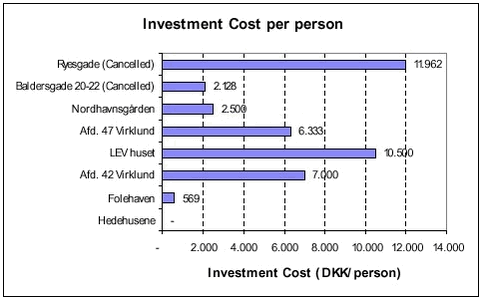
Figure A:
Investment Unit Costs
Furthermore, the payback time has been estimated for the treatment systems for which information about investment costs, water savings and operating costs were available. The estimated payback time periods appear from figure B.
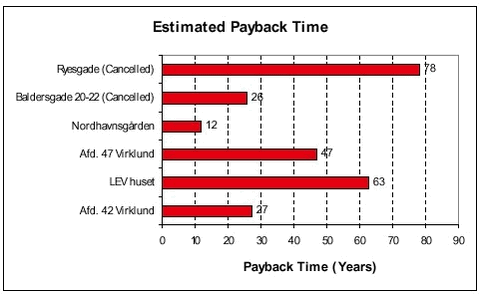
Figure B:
Payback Period
Figure C gives a summary of the produced greywater quantity per person per day. The average is estimated at 31 l/pxd (except for Folehaven, which only reuses wash water from washing machines at a common laundry). By comparison, the average consumption for toilet flushing for a normal household was 35.4 l/pxd in the year of 2000.
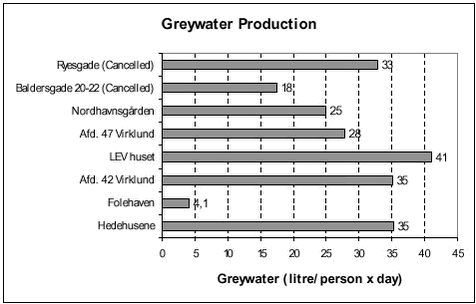
Figure C:
Greywater Production
The average power consumption for treatment and distribution of 1 m3 of greywater was estimated. It should, however, be noted that the power consumption has been estimated and not measured, as no secondary kilowatt meter was available for separate registration of the consumption for greywater components.
Figure D summarises the estimated power consumption per m3 of treated greywater.
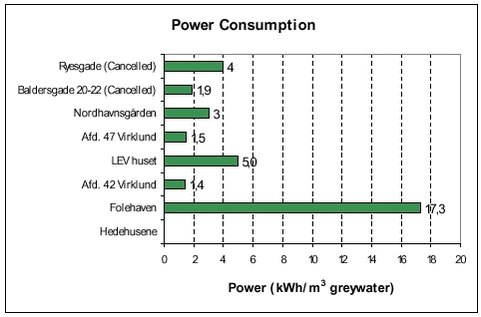
Figure D:
Power Consumption per m3 of Greywater
The total operating costs were estimated on the basis of information collected at the inspection of the treatment systems. The results are represented in figure E below.
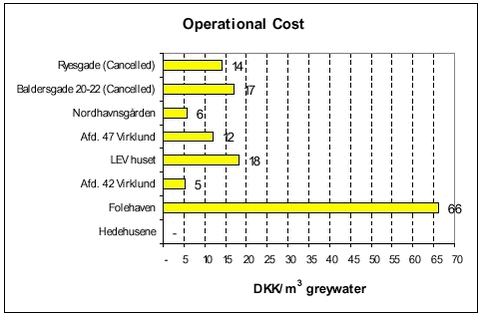
Figure E:
The operational Costs per m3 of Greywater
The estimated level of DKK 5-66 per m3 of greywater may be compared with the fact that in the year 2000 /9/ the operating costs at 111 municipal and private water supply plants were estimated at an average of DKK 5.28 per m3 with a variation of DKK 1.46 18.08 per m3.
Purification Efficiency of Greywater Treatment Systems
As part of the project a screening of the greywater treatment system at the location Virklund, afd. 47, was conducted. At this location a reduced sampling and analysis programme was implemented in the course of three days in the month of April 2002.
The analysis results demonstrated the following:
- The inlet analyses of the physical-chemical and bacteriological parameters demonstrated exceptionally low values compared to a characteristic composition of greywater.
- Due to the low inlet level it makes no sense to estimate the purification efficiencies of the chemical parameters of the system. As to the bacteriological indicator parameters bacterial count - growth at 22oC and 37oC - as well as Enterococci) the reduction was estmiated at 17-83%.
- The outlet from the cisterns does not meet the Danish quality requirements for drinking water with respect to the microbiological parameters, and, furthermore, three of the analyses do not meet the requirement for turbidity.
- The reason for the increased content of microbiological indicator parameters at the treatment system at the location Virklund, afd. 47 mainly is that the water does not undergo a UV treatment right before pumping into the cistern.
Beyond the treatment results from Virklund, afd. 47, the experience base is modest at present. The results from other fullscale plants and tests are illustrated in table F below.
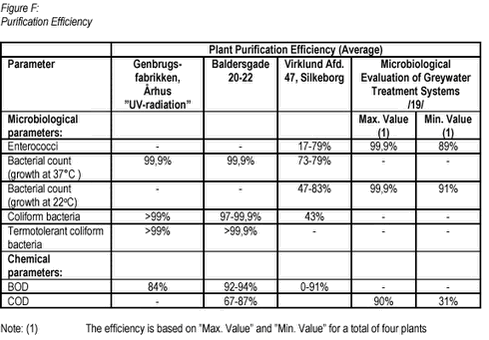
Klik på billedet for at se html-versionen af: ‘‘Figure F‘‘
Recommendations
- If the greywater treatment systems are to be made permanent and it is to be possible for the responsible authorities to grant permission to establish and operate these systems, amendments to the current acts will have to be made. Consequently, the Act on Water Supply will have to be amended, making it possible to grant permission / exemption for use of greywater for toilet flushing.
- It will have to be assessed whether sludge from the greywater treatment systems may be discharged and whether the emergency overflow may be connected within the framework of the current payment regulations for the public utilities and /or permission to be connected to the municipal sewage system.
- Quality requirements for the content of physical, chemical and bacteriological parameters of the greywater should be established. The drawing up of these quality requirements may be based on the similar requirements for greywater treatment systems prepared in New Zealand.
- Technical directions for the dimensioning, realisation and operation of the treatment systems should be drawn up in conformity with Direction No. 003 “Use of Storm Water for Toilet Flushing and Washing Machines in Houses” laid down by the Danish Technological Institute. Special focus should be given to the processtechnical dimensioning of the treatment systems and, thus, general guidelines for design and dimensioning should be prepared.
- Guidelines should be drawn up for the municipalities’ consideration of applications for permission to establish greywater treatment systems, including routine monitoring and control.
- Based on the experiences from the technical inspections it is recommended that requirements for a statutory service arrangement are determined, implying that an authorised plumber is to perform a service check of each treatment system at least once every year.
| Forside | | Indhold | | Forrige | | Næste | | Top |
|





